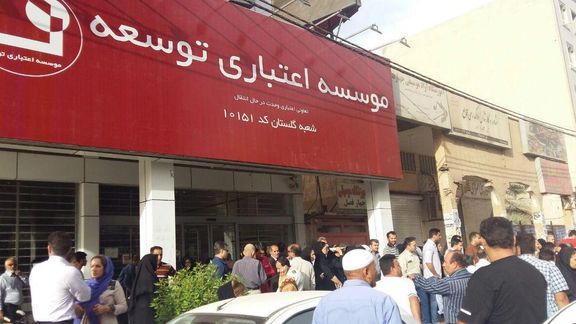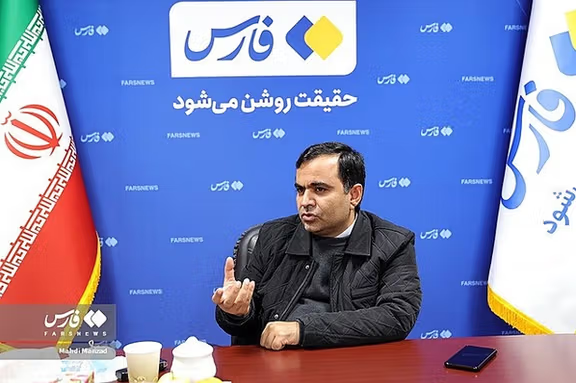Iranian Banks Liquidating As Regime Seeks To Avert Panic

Islamic Republic’s officials are in damage control mode over the Central Bank of Iran’s decision to dissolve several banks and financial institutions by October.

Islamic Republic’s officials are in damage control mode over the Central Bank of Iran’s decision to dissolve several banks and financial institutions by October.
The liquidation of Tosse-eh (Development) Credit Institution is in its final stages while the order to dissolve Ayandeh (Future) Bank was given to the Central Bank earlier this week. There are several other financial institutions, such as Caspian and Nour, that are set to dissolve or merge with other banks.
Reports of the liquidation of the unprofitable banks have been circulating in recent years, with Tosse-eh sending messages to its customers asking them to close their accounts until mid-March 2022. The institution has 30 branches all over Iran.
However, like a lot of other decisions in Iran, the liquidation never actualized, perhaps to avoid a mass panic among the population who already distrust the country’s banking system.
Lawmaker Gholamreza Marhaba, a member of the parliament’s economic committee, said Monday that according to the Constitution if a bank or financial institution strays from regulatory oversight and becomes unprofitable, the law outlines a series of measures, with the final step being dissolution or merger of the bank.
“There are unhealthy banks within the country's banking system, with some institutions in the liquidation phase, but we cannot discuss them in detail at present due to the lack of official information,” he explained.

Marhaba, however, said, “I want to emphasize that fortunately, none of the private or state-owned banks are at risk of bankruptcy. These banks have sufficient assets to easily cover their losses and compensate them. Therefore, customers can rest assured that neither Ayandeh Bank nor any other bank is facing bankruptcy.”
The Ministry of Economy seeks to exercise greater oversight over the unprofitable banks to ensure their financial stability, especially the non-state banks that have engaged in non-banking activities, he noted and said that “military organizations” had created institutions and banks that did not perform successfully, and at least five of them have so far merged into Bank Sepah, the official bank of Iran’s Revolutionary Guards (IRGC).
The dissolution of banks should not be sensationalized in the media, and discussions about the fate of such banks should be held behind closed doors “to maintain customers' confidence without tarnishing the reputation of these financial institutions,” he added in remarks typical of regime insiders who prefer to hide negative news.
A similar approach was evident in remarks by ultra-conservative lawmaker Fereydoun Abbasi who called Monday for confidentiality of economic indicators and other statistics, under claims of security risk.
Mashregh News, a hardline website affiliated with Iran's Revolutionary Guard, published an article in July titled “Countdown for Bankrupt Banks,” explaining the threats of such entities for Iran’s economy.
“Bankruptcies among Iranian banks are becoming increasingly prominent due to the country's economic crisis, posing irreversible consequences if ignored,” Mashregh News said, noting that big loans to officials with links to regime insiders – called ‘Major Debtors’ in Iranian media – as well as a lack of transparency in real asset holdings are among the major factors behind the issue.
The Central Bank of Iran issued a warning earlier in the year, giving ultimatum to underperforming banks to rectify their financial situations by late-September, with CBI Governor Mohammadreza Farzin saying that any bank or financial institution that fails may face liquidation.
Government interventions, excessive borrowing, and a lack of accountability in the banking sector are cited as other key factors leading to these bankruptcies. While some banks may be temporarily bailed out by the government, the overall trust in Iran's financial system has been significantly eroded, making it difficult for the economy to recover. Iran’s government has been aggressively borrowing from quasi-public banks to fill its budgetary gap and keep its unprofitable companies afloat.
Abbas Pourkhosravi, a banking analyst, told Mashregh News that changing the current banking structure will help prevent bankruptcies, highlighting that “unless Iran establishes connections with the international banking system, significant transformations in the country's banking system will not occur.”
Bankruptcies in the banking sector have a ripple effect, impacting various industries and causing widespread dissatisfaction among the public, Mashregh News added, warning that restoring trust in the financial system will be a challenging task, as eroded confidence can have long-lasting consequences.
The government is in debt, and the banks are even more indebted, a vicious circle that sees accumulated losses concealed from the public through manipulating financial statements on losses and loans and deferring the losses to the following year.